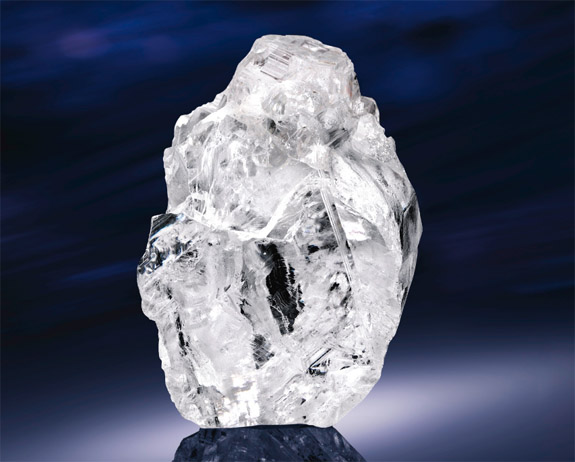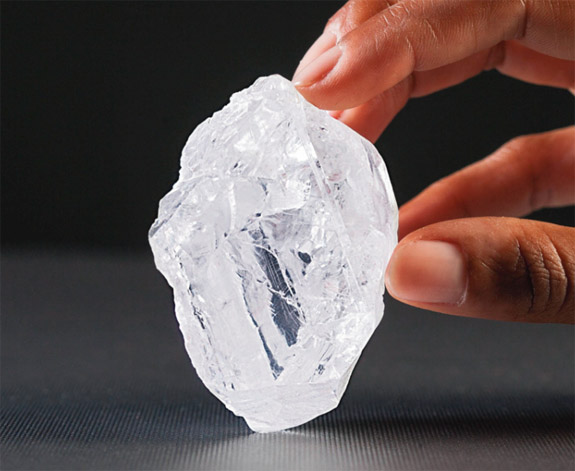An eagle-eyed trainee barely five months into his apprenticeship at Lucara's Karowe mine in Botswana is credited with plucking the 1,109-carat gem-quality diamond — now known as the Lesedi La Rona — from the mining company's "large diamond recovery" sorting machine. It was the largest rough diamond discovered in 111 years.
“At first I wanted to scream,” Tiroyaone Mathaba told The Telegraph. “Then I said in a low, hoarse voice, 'God, it’s a diamond! It’s a diamond, it’s a big diamond!’”
The rough stone is the size of a tennis ball and could potentially yield the world's largest faceted diamond, grander than even "The Great Star of Africa" at 530.20 carats.
Lesedi La Rona, which means “Our Light” in Botswana’s Tswana language, is expected to sell for $70 million or more when it's offered for sale at Sotheby's London exactly one week from today. That price would easily break the world record for any gemstone sold at auction. The current record holder is the “Oppenheimer Blue,” a 14.62-carat fancy vivid blue diamond that fetched $57.5 million at Christie’s Geneva in May.
As a trainee, the 27-year-old Mathaba had been responsible for inspecting the rock and sand produced by the mine’s large diamond recovery machines. But, on the morning of Nov. 16, 2015, he was having trouble with the equipment.
“We were experiencing a near blockage," said the recent graduate of the geology program at the University of Botswana. "I was having to work quite hard.”
Then, he spotted something shiny in his sorting tray. Was it a strange rock, or an unfathomable, mammoth-sized diamond?
Lucara geologists confirmed that Mathaba's find was the second biggest diamond ever recovered. Only the 3,106-carat Cullinan, unearthed in South Africa in 1905, was larger.
Based on the cleavage faces and sculpted surfaces of the Lesedi La Rona, Lucara experts believe the rough diamond had been much larger. In fact, some of the adjacent pieces have been recovered and matched to the larger stone.
One of the reasons why extremely large diamonds are so rare is because the stones undergo tremendous stress in the mining and sorting process. Although diamonds are the world's hardest material, they can fracture.
Lucara's new Tomra large diamond recovery machine, which utilizes X-ray transmission sensors, is designed to identify and isolate potentially large diamonds before they can be damaged. Only one day after Mathaba's discovery, two other massive diamonds — weighing 813 and 374 carats — also were found.
Despite the $70-million-plus price that Lesedi La Rona is likely to fetch, Mathaba did not earn a special bonus for finding the stone. Instead, each of the 804 people working a Lucara enjoyed bonuses related to the huge windfall. Mothaba has since become a permanent member of the Lucara staff.
Mathaba explained to The Telegraph why he finds his job so exciting: “You get to see diamonds how nature made them – the octahedron shapes, the cubes – before humans touched them.”
Credits: Images courtesy of Sotheby's.
















